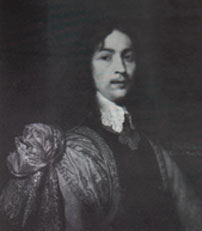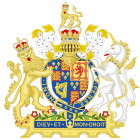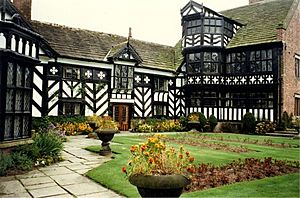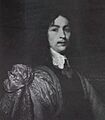Charles Gerard, 1st Earl of Macclesfield facts for kids

Charles Gerard, 1st Earl of Macclesfield (around 1618 – 7 January 1694) was an important English nobleman, a brave soldier, and a close advisor to the King. He was part of the Privy Council, a group of trusted advisors to the monarch.
Contents
Growing Up and Early Training
Charles Gerard was the oldest son of Sir Charles Gerard. His family came from Lancashire, and his great-grandfather, Sir Gilbert Gerard, was a famous judge during the time of Queen Elizabeth I. His mother was Penelope Fitton.
We don't know much about Charles Gerard's early schooling, but he studied at Leyden University in the Netherlands starting in 1633. He also learned about warfare from a young age in the United Provinces (modern-day Netherlands). When the First English Civil War began, he joined King Charles I at Shrewsbury and even formed his own group of horse soldiers.
Fighting in the English Civil War
Charles Gerard was a key figure in many early battles of the Civil War.
Key Battles and Sieges
- At the Battle of Edgehill, he led a group of Royalist foot guards. Their steady fighting helped prevent a complete defeat for the King's side. He was wounded in this battle and also during fighting near Lichfield in April 1643.
- He was at the siege of Bristol in July 1643, where he helped set the terms for the city's surrender.
- He fought well at the First Battle of Newbury in September 1643.
- He also helped relieve Newark in March 1644, where he was wounded again and captured, but soon released.
Campaigns in Wales
After these battles, Gerard was put in charge of the King's forces in South Wales. This area was strongly held by Parliament's army.
- By May 1644, he had gathered about 2,500 soldiers and began his campaign.
- He captured Cardiff and Kidwelly.
- He quickly took several castles, including Cardigan, Newcastle Emlyn, Laugharne, and Roch.
- He then moved towards Pembroke, but the local soldiers fought back and got supplies.
- By August, he had taken Haverfordwest and was surrounding Pembroke and Tenby.
In September, Gerard was ordered to join Prince Rupert in Bristol. He marched his troops back, avoiding the Parliamentarian General Edward Massey. He spent time in Oxford and Worcester before moving to Cheshire in March 1645 to help Rupert and Prince Maurice relieve Beeston Castle.
He was then sent back to South Wales, where the Parliamentarian General Rowland Laugharne had been successful. Gerard marched through Wales, winning battles and taking back places like Haverfordwest and Cardigan Castle. He also captured Picton Castle and Carew Castle. Only Pembroke and Tenby castles remained under siege.
With King Charles After Naseby
After the Royalists regained control in South Wales, Gerard was ordered to move east again. He was leading about 5,000 soldiers towards Hereford when the important Battle of Naseby took place in June 1645.
- After the King's army was defeated at Naseby, King Charles and Prince Rupert retreated to Hereford, hoping to meet Gerard.
- The King then went to Cardiff, hoping to raise a new army in Wales. However, the Welsh people were unhappy with how Gerard had treated them.
- To encourage the Welsh to help, King Charles replaced Gerard as commander but promised to make him a baron. Gerard chose the title Baron Brandon.
Gerard became Lieutenant-General of all the King's Horse and led the King's personal guard. He escorted King Charles to various places, including Oxford and Hereford. When the Scottish army surrounded Hereford, Charles and Gerard's arrival made them leave.
In September 1645, King Charles heard that Bristol had fallen. He tried to join Montrose in the north. Gerard helped him reach Chester. However, the Royalists were defeated at Rowton Heath by General Sydnam Poyntz. Gerard was badly wounded.
The King then went to Newark. Gerard was later dismissed from the King's service for supporting Prince Rupert in a protest against the removal of the governor of Newark.
Life with Prince Rupert and in Exile
After being dismissed, Gerard stayed close to Prince Rupert's group of officers. They tried to get passes to leave the country from Parliament, but Parliament wanted them to promise never to fight against them again.
- Gerard eventually returned to the King's side in Oxford. He formed another group of horse soldiers.
- He seems to have been at Wallingford Castle for a time and then stayed within Oxford's walls until the city surrendered in June 1646.
- He likely left England with Rupert and was in The Hague (Netherlands) by December 1646.
Years in Exile
From 1646 until the Restoration (when the monarchy was brought back), Gerard's movements are hard to track.
- He was in France in 1647 with Rupert.
- In November 1648, he was made vice-admiral of the fleet.
- By April 1649, he was in The Hague as a Gentleman of the Bedchamber to King Charles II. This meant he was a close attendant to the King.
- He was part of the group that advised King Charles II to work with the Scottish Parliament.
- He was praised by important figures like Edward Hyde and Secretary Nicholas for his loyalty and courage.
- In 1653, he traveled to Utrecht and later served as a volunteer soldier under Marshal Turenne at the siege of Arras.
- He returned to Paris, where he gathered information for the King. He was accused of being involved in a plot to harm Oliver Cromwell, the leader of England at the time, but this story is likely false.
Return to England
Gerard continued to travel between the Netherlands, France, and Belgium, gathering intelligence and helping the Royalist cause.
- In the spring of 1660, Gerard joined King Charles II at Breda (Netherlands).
- In May 1660, he returned to England with the King.
- On 17 May 1660, he became a Captain in the Life Guards and rode at their head during the King's grand procession to Whitehall on 29 May 1660.
After the Monarchy Returned
After the King returned to power, Charles Gerard received many honors and positions.
Quick facts for kids Restoration of Lord Gerrard Act 1660 |
|
|---|---|
| Act of Parliament | |

|
|
| Long title | An Act for restoring to Charles Lord Gerard, Baron of Brandon, all his Honours, Manors, Lands, Tenements, and Hereditaments, whereof he was in Possession on the 20th Day of May, 1642, or at any Time sithence. |
| Citation | 12 Cha. 2. c. 8 |
| Dates | |
| Royal assent | 13 September 1660 |
- On 13 September 1660, his lands, which had been taken by Parliament, were given back to him.
- In 1661, he became the ranger of Enfield Chase, a large hunting ground. He had some legal arguments over this position.
- In 1662, he received a regular payment from the government.
- He was sent as a special envoy to the French court, where he was welcomed with great honor.
- He became a member of the Royal African Company, a trading company.
- He was involved in a long legal dispute with his cousin, Alexander Fitton, over the ownership of the Gawsworth estate in Cheshire. Gerard won the case, and Fitton was imprisoned for insulting a peer.
- In 1665, he was given a yearly payment to step down from his role as captain of the guard, so the King's son, the Duke of Monmouth, could take the position. He eventually left the role in 1668.
- In 1667, he was put in command of the militia in Hampshire and the Isle of Wight, focusing on strengthening Portsmouth's defenses against the Dutch.
- He remained a Gentleman of the Bedchamber to King Charles II.
Later Life and Politics
- On 23 July 1679, he was given the higher title of Earl of Macclesfield.
- He was involved in political events, including supporting the Exclusion Bill, which aimed to prevent the King's Catholic brother, James, from becoming king.
- In 1681, he was removed from his position as Gentleman of the Bedchamber.
- The legal dispute over the Gawsworth estate was brought up again in 1684. Even though Gerard was against the King's party at the time, the judge ruled fairly and upheld Gerard's claim.
- In 1685, he was declared an outlaw and had to flee to Europe.
Return with William III
Charles Gerard spent the next three years in Germany and the Netherlands. He returned to England in 1688 during the Glorious Revolution, when Prince William of Orange came to take the throne.
- Gerard commanded William's bodyguard, a group of about 200 English horsemen, during his journey to London.
- In February 1689, he became a member of the Privy Council again.
- He was also appointed Lord President of the Council of the Welsh Marches and lord-lieutenant for several counties in England and Wales.
- His outlawry was officially reversed in April.
- He died on 7 January 1694 and was buried in Westminster Abbey. His titles and estates passed to his son, Charles.
Family Life
Charles Gerard married Jane de Civelle, a French woman living in England. They had two sons and three daughters:
- Charles (around 1659–1701), who inherited his father's title.
- Fitton (1663–1702), who became the Earl after his brother died.
- Elizabeth, who married Digby Gerard, 5th Baron Gerard of Bromley.
- Charlotte
- Anne
Images for kids




